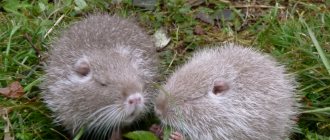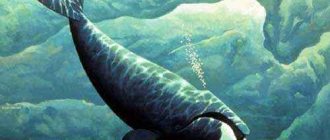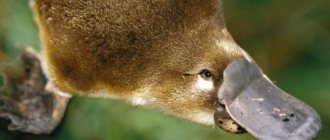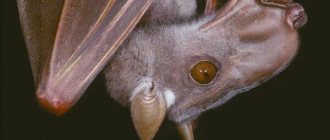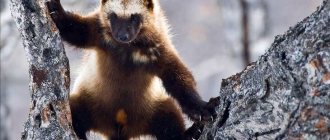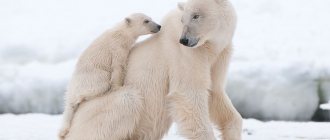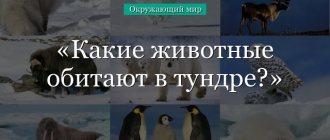- Wild animals
- >>
- Mammals
The musk ox is an incredible animal that has a very specific appearance, thanks to which zoologists have identified it as a separate order. The name is due to the external characteristics of both sheep and bulls. The animal adopted the physique and structure of internal organs and systems from bulls, and the type of behavior and some features from sheep. In many literary sources it is found under the name musk ox.
Origin of the species and description
Photo: Muskox
The musk ox belongs to the chordates, classified into the class Mammals, order Artiodactyls. It is a representative of the bovid family, genus and species of musk oxen. The name of the animal translated from ancient Latin means ram-ox. This is due to the inability of scientists to come to a consensus regarding the origin and ancestors of the animal.
Video: Muskox
The ancient ancestors of modern musk oxen lived on earth during the Miocene period - more than 10 million years ago. Their habitat at that time was the mountainous areas of Central Asia. It is not possible to accurately determine and describe the appearance, character and lifestyle of ancient ancestors due to the lack of a sufficient number of fossils.
About 3.5-4 million years ago, when climatic conditions became more severe, ancient musk oxen descended from the Himalayas and spread across northern Eurasia and Siberia. During the Pleistocene period, primitive representatives of this species, along with mammoths, bison and rhinoceroses, very densely inhabited Arctic Eurasia.
During the Illinois glaciation, they migrated along the Bering Isthmus to North America, then to Greenland. The first musk ox in Europe was discovered by an employee of the Hudson's Bay Company, the Englishman Henry Kelsey.
MUSKOX
Volume 23. Moscow, 2013, pp. 638-639
Copy bibliographic link:
MUSKOX, musk ox (Ovibos moschatus), mammal of the family. bovids. Body length of males up to 250 cm, females up to 200 cm, height at withers approx. 120 cm, weight from 180 to 400 kg. Outwardly it looks like a medium-sized bull, covered with thick, long and dense hair, or like a giant ram (hence the name). The fur on the underside of the neck hangs almost to the ground, and there are numerous downy hairs. Bulls emit a strong musky odor, especially during the rut (hence the second name). The head is disproportionately large, the ears and short tail are hidden under the fur. Horns in males are up to 73 cm long, in females - up to 40 cm; they are strongly flattened at the base and are located in the middle of the frontal part of the skull, descend down along the head, at the ends they rise and bend upward, in old animals they close together at the bases. Winter color is from dark brown to black-brown, in summer it is dark brown with shades of gray. The back of old males is yellow-brown. O. is a contemporary of the mammoth. The species formed in Eurasia in the Pleistocene, then presumably 200–90 thousand years ago penetrated into the North. America. Spreading eastward, it reached Greenland in the Holocene. The last Asian population died out on the Taimyr Peninsula 2 thousand years ago. K ser. 20th century preserved in the tundras of the North. America (Canada), in the Arctic. islands. Acclimatized in Sweden and Norway, in the middle. 1970s - in Russia, on about. Wrangel and the Taimyr Peninsula, in the end. 1990s in Yakutia. Nowadays in Russia there are approx. 40 thousand individuals. Lives in lowland and mountain tundras, feeds on various species. herbaceous plants, shoots of shrubs, mosses, lichens. In the warm season, animals stay in small groups of 8–20 individuals, including males and females with young animals. In winter they form small herds, sometimes up to 50–100 animals. Characterized by collective defense against predators. The rut takes place in July – early September. Pregnancy approx. 9 months, 1 cub in litter, lactation 3–6 months. Sexual maturity occurs at 3–4 years of age. Life expectancy is 12–20 years. Hunted object of the local population. Sometimes O. are kept as pets, using meat, wool, and milk. The number of the species is stable, its condition does not cause concern.
Source
Appearance and features
Photo: What a musk ox looks like
The musk ox has a very specific appearance, which is formed by the conditions of its existence. There are practically no bulges on his body, which reduces heat loss. Also, a specific feature of the animal’s appearance is its long and very thick fur. Its length reaches about 14-16 centimeters in the back and up to 50-60 centimeters in the sides and abdomen. Outwardly, it seems that it was covered with a luxurious blanket on top.
Interesting fact: In addition to wool, the musk ox has a thick and very dense undercoat, which warms 7-8 times more intensely than sheep's wool. The coat of an artiodactyl consists of eight types of hair. Thanks to this structure, he is the owner of the warmest wool in the world.
In winter, the fur is especially thick and long. Molting begins in May and lasts until mid-July. Animals are distinguished by powerful, well-developed muscles. The musk ox has a rather large head and a short neck. Due to his massive, sagging fur, he seems much larger than he actually is. The front, front part of the head is also covered with fur. The ears are triangular in shape and practically invisible due to the thick fur. The musk ox has massive sickle-shaped horns. They are thickened in the forehead area, covering most of it.
Horns can be grey, brown or brown. The tips are always darker than the base. The length of the horns reaches 60-75 centimeters. They are present in representatives of both sexes, but in females they are always shorter and less massive. The limbs of bulls are short and very powerful. It is noteworthy that the front hooves are more massive than the hind hooves. The limbs are covered with thick and long fur. The tail is short. It is abundantly covered with fur, making it completely invisible.
The height of the animal at the withers is 1.3-1.5 meters. The body weight of one adult individual is about 600-750 kilograms. The color scheme is dominated by grey, brown, brown and black. Usually the upper part of the body has a lighter tone, the lower part is almost black. There is a light stripe in the spine area. The limbs are also covered with light fur.
Price
Despite their rarity, bordering on uniqueness, animals are sold in one form or another. You can find offers to sell young animals. The price of a musk ox is usually set depending on the number of individuals purchased and where they came from. Farms and zoos can act as sellers.
Presumably, the cost of one animal will be in the range of 50 - 150 thousand rubles. In addition to calves and adult animals, musk ox wool appears on sale. This is valuable material. Experts say that giviot (or giviut) - the underwool from which wool threads are spun - is 8 times warmer and 5 times more expensive than sheep's wool.
The rarity of musk ox wool is not the only difficulty that arises when acquiring it. Some experience is required to be able to make sure that it is musk ox wool that is being offered. When buying a giviot online, the only hope to avoid counterfeiting is the reviews and authority of the seller.
Where does the musk ox live?
Photo: Muskox in Russia
The historical habitat of the animals extended to the Arctic regions of Eurasia. Over time, along the Bering Isthmus, musk oxen migrated to North America, and even later to Greenland.
Global changes in climate conditions, in particular warming, have caused a reduction in the number of animals and a narrowing of their habitat. The polar basin began to shrink and melt, the amount of snow cover increased, and the tundra-steppes turned into swampy areas. Today, the main habitat of the musk ox is in North America, in the area of Greenel land and Pari land, as well as the northern regions of Greenland.
Until 1865 inclusive, the musk ox inhabited the northern regions of Alaska, but in this territory they were completely eliminated. In 1930, they were again brought there in small numbers, and in 1936 to the island of Nunivak. The musk ox has taken root well in these places. In Switzerland, Iceland and Norway it was not possible to breed the animals.
In the recent past, bull breeding began in Russia. According to rough estimates by scientists, approximately 7-8 thousand individuals live on the territory of the Taimyr tundra, about 800-900 individuals on Wrangel Island, as well as in Yakutia and Magadan.
Now you know where the musk ox lives. Let's see what the animal eats.
Area
Historically, musk oxen have occupied Alaska, northern Canada and parts of Greenland, although the current range has declined significantly as the species has been driven to extinction in some areas over the past century. Currently, musk oxen can be found in Alaska, in areas of Greenland, Russia, Norway and Spitsbergen.
What does a musk ox eat?
Photo: Animal musk ox
The musk ox is a cloven-hoofed, herbivorous animal. It managed to adapt and survive perfectly in the climatic conditions of the cold Arctic. In these places, the warm season lasts only a few weeks, then winter comes again, snow storms, winds and severe frosts. During this period, the main source of food is dry vegetation, which animals extract from under a thick layer of snow cover with their hooves.
Food supply of the musk ox:
- birch, bush willow;
- lichens;
- moss, moss;
- cotton grass;
- sedge;
- astragalus and mytnik;
- arctagrostis and arctophila;
- partridge grass;
- foxtail;
- reed grass;
- meadow grass;
- mushrooms;
- berries.
With the onset of the warm season, musk oxen come to natural salt licks, where they replenish the lack of minerals and trace elements in the body. In winter, animals get their food by digging it out from under the snow cover, the thickness of which does not exceed half a meter. If the thickness of the snow cover increases, the musk ox will not be able to obtain food for itself. In the cold season, when the main source of food is dry, frozen vegetation, musk oxen spend most of their time digesting it.
With the onset of warmth, they try to stay close to river valleys, where the richest and most diverse vegetation is. During the warm season they manage to accumulate enough fat mass. By the time cold weather sets in, it makes up about 30% of body weight.
Meager diet
The food of musk oxen is seasonal: during the short and rather cool summer, the animals have the opportunity to feast on fresh herbs, sometimes leaves of bush willows and birches, berries and mushrooms. The rest of the year they have to make do with dry plants, mosses and lichens, which they dig out from under the snow. To compensate for a very meager diet and replenish mineral reserves, immediately after the snow melts, musk oxen prefer to visit salt licks, rich in minerals.
Features of character and lifestyle
Photo: Siberian muskox
The musk ox is an animal that is perfectly adapted to survive in cold, harsh climates. They can often lead a nomadic lifestyle, choosing areas where there is opportunity to feed themselves. In winter, they often migrate to the mountains, as strong winds sweep away snow cover from their peaks. With the onset of spring, they return to the valleys and flat areas of the tundra.
The lifestyle and behavior of the musk ox often resembles sheep. They create small groups, the number of which in summer reaches from 4 to 10 individuals, in winter up to 15-20. In spring, males often gather in separate groups or lead a separate, solitary lifestyle. Such single animals account for approximately 8-10% of the total number of animals.
Each group has its own habitat and grazing territory. In the warm season, it reaches 200 square km, in the summer it decreases to 50. Each group has a leader who guides everyone in the search for food resources. Most often, this role is performed by the leader or an adult, experienced female. In critical situations, this function is assigned to the herd bull.
Animals move slowly, in some situations they can speed up to 35-45 km/h. Able to travel long distances in search of food. In the warm season, they alternate feeding with rest during the day. With the onset of winter, they rest most of the time, digesting the vegetation that they obtain under the thickness of the snow cover. The musk ox is not at all afraid of strong winds and severe frosts. When storms begin, they lie with their backs to the wind. A particular danger for them is high snow, which is covered with crust.
It navigates in space with the help of well-developed vision and smell, which allows it to sense the approach of an enemy and find food under the thickness of the snow. The average lifespan of a musk ox is 11-14 years, but with a sufficient amount of food this period almost doubles.
Habitat
Musk oxen are full-fledged inhabitants of the Arctic tundra. In summer they tend to use sheltered and moist lowlands, such as river valleys and lake shores, and in winter they move to higher slopes, where strong winds prevent the accumulation of deep snow, thus making feeding easier.
Musk oxen are well adapted to the cold and are one of the few large mammals that can live year-round in the harsh Arctic climate. The thick coat provides excellent insulation, and the musk ox's short, stocky legs and rounded hooves allow it to move across snow.
Social structure and reproduction
Photo: Muskox in nature
The breeding season lasts from mid-July to the end of October. All sexually mature females ready for mating are covered by one male, who is the leader of the herd. In those groups where the number of heads is too high, several more subdominant male individuals continue the family. There is practically no competition for the attention of females.
Sometimes males show strength in front of each other. This manifests itself in head tilts, growling, butting, and hooves hitting the ground. If the opponent is not ready to concede, fights sometimes occur. The animals move fifty meters away from each other, and, running away, collide with their foreheads. This happens until the stronger one defeats the weaker one. Often males even die on the battlefield.
After mating, pregnancy occurs, which lasts 8-9 months. As a result, very rarely two cubs are born. The body weight of newborns is about 7-8 kilograms. A few hours after birth, the babies are ready to follow their mother.
Mother's milk is quite high in calories and has a high percentage of fat content. Because of this, newborn babies grow quickly and gain body weight. By two months they have already gained about 40 kilograms, and by four months they have doubled their body weight.
Feeding with breast milk lasts at least four months, sometimes lasting up to a year. A week after birth, the baby begins to try mosses and herbs. At the age of one month it already actively feeds on pasture vegetation in addition to mother's milk.
The newborn is under maternal care for up to a year. Herd cubs always form groups to play together. Among newborns, males always predominate.
Sexual dimorphism
Sexual dimorphism is quite pronounced. Males and females differ not only in behavior, but also in anatomy. The weight of males reaches about 400 kilograms with a height of up to one and a half meters. While females have a maximum height of 1.2 meters and weigh up to 240 kilograms.
The difference between the sexes also lies in the appearance of the horns. Males are endowed with more massive and longer horns with a length of up to 73 centimeters. Women's horns are almost half as long as men's. Also noteworthy is the fact that in females there is white fluff where the horns grow.
Sexual differences also lie in the timing of puberty. The female becomes fertile at 2 years, and if there is enough food, at 15 months, while males are no earlier than 2.5 - 3 years of age.
Natural enemies of musk oxen
Photo: What a musk ox looks like
Musk bulls are naturally endowed with powerful and strong horns and very developed muscles. They are quite united, which often allows them to repel their enemies. Despite this, they have quite a lot of enemies in their natural habitat.
Natural enemies of musk oxen:
- wolves;
- brown and polar bears;
- wolverines.
Another very dangerous enemy is man. He often hunts the animal for its horns and fur. Connoisseurs of such rare trophies value them very highly and offer big money. A keen sense of smell and very sharply developed vision often make it possible to determine the approach of danger from afar. In such a situation, musk oxen accelerate the pace of movement, begin to gallop, and then begin to flee. In some situations, they are capable of reaching speeds of more than 40 km/h.
If such tactics do not bring the desired effect, the adults form a dense ring with the young cubs in the center. Reflecting the attack of the predator, the adult returns to its place in the circle. This defense tactic makes it possible to quite effectively defend against natural enemies, but it does not help, but on the contrary, it makes the task easier for hunters who do not even have to pursue their prey.
Behavior
Musk oxen have a characteristic defensive behavior in which the herd gathers together, often forming a line or circle with the young inside and the sharp horns of the adults pointing upward. Musk oxen tend to form mixed herds of about 10 to 20 individuals, and sometimes more than 100. Males can also be found alone or in separate bachelor herds. In summer, small groups form a harem, led by a dominant male, with rivals eliminated through threats, actions or serious fighting. The battle between males for dominance is an impressive spectacle and is accompanied by clashes and roars that can be heard from long distances.
Nutrition
The musk ox is an absolutely herbivorous representative that was able to adapt to the scarcity of food supplies in the Arctic. Summer in this region lasts only a couple of weeks. Musk oxen are forced to feed on vegetation located under a large thickness of snow cover.
Plants that make up the diet of musk oxen:
In summer, animals actively accumulate nutrients by feeding on natural salt licks.

